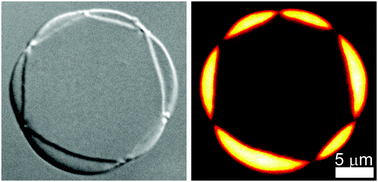Self assembly of cyclic polygon shaped fluid colloidal membranes through pinning†
Abstract
2D fluid monolayer membranes of rod-like viruses spontaneously form in a mixture of rods and polymers through depletion attraction. The rods are uniformly oriented within the bulk and twist in a zone around the membrane edge. Surprisingly, we find that cyclic polygonal shaped colloidal membranes form when polymers are added to a mixture of long and short-thick rods with the long and short-thick rods forming the faceted core and lobes of the polygon, respectively. We demonstrate that the origin of this anisotropic shape lies in the phenomenon of spreading of one liquid over another in the presence of disorder. As a membrane of short-thick rods spreads over another of longer rods, the edge bound rods untwist to become part of the newly formed two-rod interface. However, a small fraction of rods fail to untwist as the two rod interface forms and act as mobile pinning centers. Capillary flow of short-thick rods drives all the pinning centers to a single location in the composite membrane which now acts like a junction. This pinning junction inhibits complete engulfing of one membrane by the other. Repeated sequential events like this then lead to formation of multiple junctions and the overall cyclic polygon topology. We find that pinning junctions are weakly cross-linked in nature instead of being topological defects. We outline the necessary and sufficient constraints on the nature of rods to obtain stable out of equilibrium cyclic polygon membranes. Our results show a unique counter-intuitive scenario where defects lead to self-assembly of ordered structures.



 Please wait while we load your content...
Please wait while we load your content...